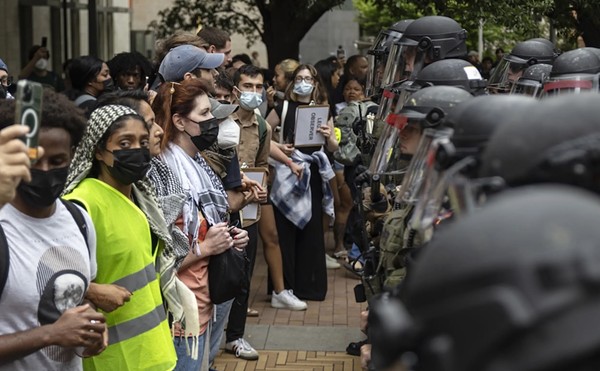It's February 22, 2010, and the second monthly meeting of San Antonio's Dangerous Structures Determination Board is in session in the City Council chambers. Projected on the giant screens in the front of the room are images of deep urban decay: rotting wood, exposed floor beams, cement piers moldering in a pile, holes in the roof big enough to accommodate 'possum ... drug paraphernalia on a side table. That's what we're told it is anyway. I'm not sure, because I'm fixated on the bed, which seems to be in a room that is at least partially open to the elements. Yet, it has bedding, and what looks like a row of clothes hung neatly on nails sticking out of the wall studs. Someone is living here? Someone who needs help, from the looks of it.
But any assistance rendered today will be of the tough-love variety.
The faces on the dais are not as familiar as District 1 Council Member Mary Alice Cisneros's, or as famous as Mayor Julian Castro's, but they wield a power as awesome as any held by our local elected leaders. By a simple majority vote, these six individuals can order a house demolished, any tenants relocated, and send the bill ($4.12 per square foot) to the owner. A quorum is four, so some days fate rests in even fewer hands.
A police officer tells the board that squatters on the property "confessed to using drugs on a regular basis." A second officer reminds them that the house is just north of the "Hackberry area," which is known for prostitution and drugs. A Fire Department representative asks about missing flooring, and the board votes unanimously to demolish the house.
• Police Action
Our property rights, enshrined in the Constitution, are not absolute, a fact brought home with force and rancor by the 2005 Supreme Court ruling in Kelo v. City of New London, which held that the definition of “public good” for which the government can take private property includes private redevelopment projects. Of course, in those cases, property owners must be compensated.
The other notable instance in which the government can interfere with your property rights is when you neglect or operate your property in such a way that it becomes a danger to others. A brief submitted by the cities of Houston and San Antonio in a case currently before the Supreme Court of Texas sums it up this way: “All property in Texas is held subject to the government’s valid exercise of its police powers to protect the public safety.” The U.S. Supreme Court has held that once a property is declared a public nuisance, the compensation provisions in the Takings Clause no longer apply.
In Texas, the task of determining which structures are such a nuisance that there’s no other course of action but to tear them down is delegated to what’s known in the legal world as “quasi-judicial bodies.” To the layperson that means local administrative boards that are neither elected nor actually judges; to City officials, it means a way to get rid of problem properties without the time and expense of going through the actual court system. That same legal brief before the Texas Supremes laments the days “prior to the enactment of these statutes when all public nuisances had to be judicially determined — a process which could be drawn out for years and often was, while the structure continued to deteriorate even further and often collapsed.”
Speed and efficiency, however, are achieved at a steep price.
“When you’re in front of the DSDB, one of the things you don’t get to do is ask questions of the witnesses,” says attorney Eddie Bravenec, who has represented several clients with cases before the board. “You have to ask questions of the board, and then the board gets to ask the witnesses questions.”
Those witnesses, including the code-enforcement officers who inspected the properties and, increasingly frequently, San Antonio police officers, aren’t under oath, unlike witnesses in an actual court proceeding, and so aren’t subject to perjury. Property owners don’t have the right to object to members of the DSDB whom they believe might not be impartial in their cases, and unlike criminal trials, they’re not entitled to legal representation — if you can’t afford an attorney, that’s the breaks.
These shortcomings are of greater concern as an increasing number of DSDB cases begin to look like law-enforcement actions.
In spring 2008, the City of San Antonio created an interdisciplinary enforcement group under the City Attorney’s office called the Dangerous Assessment Response Team, which works closely with the police to target properties with high crime rates. One of DART’s great advantages, says Assistant City Attorney Joe Niño, is that once a property is brought to the City’s attention through one agency, “DART looks at it from all angles.” In other words, your neighbors may call and complain about the tire pile in your driveway, but if the complaint ends up with DART, the police may check in, too. Or repeated police calls can bring on fire and safety inspections. DART then uses those violations as leverage to negotiate voluntary compliance with property owners, or to take them to court or to the DSDB.
The City’s dangerous-structures ordinance allows the DSDB to raze houses that have “become so dilapidated or deteriorated or neglected as to become a harbor for vagrants or criminals.” Since DART’s inception, it has become common for officers to testify that not only is a house a wreck, it’s a magnet for drugs, prostitution, and related criminal behavior. Based on a rough survey of DSDB minutes from January 2009-January 2010, the DSDB voted to demolish structures in 90 percent of the cases in which a police officer said that it was a source of criminal activity. In contrast, the board issued demolition orders in just over 60 percent of the cases in which police officers didn’t speak; that number would be much lower if we excluded cases in which the owner said they were planning to demolish the property themselves or agreed to the demolition, and cases in which no one signed up to speak (the other almost-surefire way to lose in front of the DSDB).
According to the City’s annual report, in its second year of operations DART “directed enforcement efforts against 59 nuisance properties.” One of those properties was the modest 1930s bungalow at 115 Blue Bonnet. At the September 14, 2009, DSDB meeting, San Antonio Police Officer Charles Hiller registered his concerns about the house. According to the minutes, he “stated that someone was murdered in this structure over a drug deal,” and that “this structure is a haven for drug and prostitution activities.” Officer Jose Buso seconded the drug complaint, and added that “neighbors are afraid of retaliation from the owner and his friends if they complain about this structure before the Board.”
The owner, in fact, was dead, the victim of that 2007 shooting. The SAPD offense report says that Allen Monroe, age 56, was found shot inside his front door on a warm May morning. Police recovered a 9 mm shell casing, and animal control was called to the scene to remove numerous dogs and cats. There is no mention of drugs. SAPD declined to let the Current speak to Officer Hiller and instead directed us to Assistant City Attorney Savita Rai, DART’s de-facto boss, who after an initial conversation earlier this year has failed to return multiple calls for comment.
Just before the Blue Bonnet hearing, Officer Mary Dye dropped the dime on the house at 851 S. San Bernardo. Dye “Stated that this location has been an eyesore for a long time. Stated that the owners are heroin addicts. Stated that this structure is a harborage for drug and prostitution activities. Stated that this location is a known ‘fence location’ for buying stolen items.” If any of the board members questioned the accuracy or personal knowledge of any of this testimony, it’s not recorded in the minutes. In both cases, the board voted 4-0 to demolish the structures.
Shanon Peterson Wasielewski, the City’s historic preservation officer, regularly sits on the DSDB board. Of the police-officer testimony, she says, “I think it changes the issue because sometimes the discussion can become more about the crime than the structure’s habitability. … The flip side is, I have often said on the record at DSDB, houses don’t smoke crack. Just by itself `razing a troubled property is` not really solving the problem.”
This state of affairs might be tolerable, if not ideal, if there were a meaningful way to challenge the board, but the courts have so far shown these “quasi-judicial” bodies a very judicial deference. A property owner who is unhappy with the board’s decision can challenge it in court, but the judge must let the ruling stand if any evidence — “more than a mere scintilla” — in the official DSDB record supports the board’s finding. The property owner cannot introduce any evidence that wasn’t recorded as part of the original hearing.
Take the house on Blue Bonnet: The late Allen Monroe’s cousin, Eddie Ansari, disputes the officer’s account of his murder. “Allen moved back into the house when he lost his job,” Ansari says. “But he was never into selling drugs.” Problem is, Ansari wasn’t at the DSDB hearing, so a reviewing court can’t weigh his testimony against the City’s.
The police documents that might support or refute officers’ assertions about crime and drugs aren’t part of the permanent DSDB files, either. Dangerous Premises Supervisor Danny Liguez told the Current that’s a privacy issue — despite the fact that the officers speak at a public hearing, and the minutes are public record. Niño simply says “It’s not required. The police officer can speak on behalf of the property like any other individual.”
Except their testimony isn’t like “any other individual,” because according to the City, repeated criminal activity alone is reason enough to tear down a house. “It boils down to whether it’s a nuisance,” Niño said. Even a King William mansion with no other code issues? “If they wanted to.”
But a property owner who appealed the DSDB decision in court would have only the record to go on, and the record might have only the he-said, she-said of the individuals who spoke before the board.
“They’re not proving they’re using drugs, or showing they’re using drugs,” Bravenec said. “They’re saying they’re using drugs, so we have no way to test that.”
Who is the DSDB?
San Antonio’s Dangerous Structures Determination Board is composed of six City employees designated by the City Manager from Grants Monitoring and Administration, Planning and Development Services, the Department of Community Initiatives, the Fire Department, the Office of Historic Preservation, and Public Works. Although six individuals are currently tapped as regulars, the DSDB liaison emails them approximately 10 days before meetings so that alternates can be selected if necessary.
The current slate of regulars includes Rose Arredondo (Grants), Robert Browning (Public Works), Michael Constantino (Planning), Armando Perez (Fire), Deborah Vasquez (Community Initiatives), and Shanon Peterson Wasielewski (Historic Preservation). They meet at 8:30 a.m. the second and fourth Monday of each month in City Council chambers. The agenda is posted the Thursday beforehand at webapps.sanantonio.gov/boardcomm/.
• Who’s watching the DSDB?
Current readers will recall the sad tale of outsider artist Reverend Seymour Perkins, whose Eastside house and studio the City accused of harboring drug dealers and prostitutes. After a two-year legal battle, during which Perkins died, it was demolished this past December. In a case Bravenec took to the Texas Fourth Court of Appeals, the justices ruled that the trial court was right when it refused to consider any information related to the demolition order outside of the official DSDB record. Bravenec is now bringing another case to the Fourth based on a footnote in the Perkins opinion, which reads: “We note, however, that in addition to reviewing whether substantial evidence supports the Board’s order, an arbitrary action of an administrative agency cannot stand, including any action that deprives a party of due process; therefore, the trial court also is permitted to consider whether the proceedings before the Board satisfied the requirements of due process.”
Bravenec argues that San Antonio’s dangerous-structures system denies property owners due process because the DSDB is composed entirely of City employees selected by the City Manager. A courtroom trial “is a whole bunch of people that are watching each other that keep each other honest,” he says: the opposing counsel, the judge, the bailiff, the court reporter. The DSDB, on the other hand has six City employees, watched by the City Attorney, ruling in a case presented by other City employees. “Rather than have people watch each other, you have people colluding with each other.” Statistics ought to tell us something, he suggests: By the Current’s tally, in 206 votes recorded between January 2009 and January 2010, the board acted unanimously more than 97 percent of the time.
“It’s been like that for years,” Niño says of the board’s makeup. “It’s kind of a City Council decision.” But he says that neither DART nor the City Attorney’s office has any sway over DSDB decisions. “It’s an independent board that acts on what they hear.”
In 2006, when the City merged its Code Compliance and Neighborhood Action departments, the City eliminated the Neighborhood Action seat on the DSDB to avoid what it saw as a possible conflict of interest, but the line between the board and the City is hardly firm or bright. To cite just one example, Savita Rai, who instigated and works with DART, is often listed as the City’s legal counsel at DSDB meetings — the person that board members might consult if, e.g., a property owner challenged the impartiality of a DSDB member.
And there’s good reason to question their impartiality. Bravenec draws a comparison to the recent Supreme Court ruling in Caperton v. A.T. Massey Coal Co. that reversed a West Virginia judge who didn’t recuse himself from a trial in which the appellants had virtually funded his successful election campaign. The Due Process Clause, the court said, requires recusal in cases where a judge has “a direct, personal, substantial, pecuniary interest,” or where “the probability of actual bias on the part of the judge or decisionmaker is too high to be constitutionally tolerable.”
“I fail to see how getting your paycheck from a party isn’t a pecuniary interest,” Bravenec says.
• A mixed message
The Constitution is nowhere to be found in the minutes for 114 Kontiki Place, which came before the DSDB on March 8. Among the offenses the code officer listed are “contains graffiti,” “contains drug paraphernalia; and spray cans were found on location.”
Owner Juanita Villarreal addressed the board, which included representatives from Planning and Development Services, the Office of Historic Preservation, Grants Monitoring and Administration, the Fire Department, and the Department of Community Initiatives. Her husband is disabled and on Social Security, she told the board. She is also disabled and able to work only four hours a day. Anticipating the police testimony to come, she said her sons are not in gangs; they haven’t been arrested for any gang-related activity … “people shoot at their house because one of her sons is a drug addict and owes people money.” Finally, she reminded the board that she and her husband live in the house.
Then it was Officer Marc Valero’s turn. He’s a 16-year veteran, he told the board, and a member of the SAPD’s San Antonio Fear Free Environment Unit, which focuses on gang activity and graffiti. He “stated that the sons’ friends live there and they all claim to be in a gang called Five Palms Blood. Stated that they have a website on MySpace and YouTube where they have pictures holding drugs and guns.” Police had answered 33 calls in the past three years, he said (true), 12 of them in the last two months (also true), six in the past two weeks (four by our count). One of the sons was arrested and charged with possession of drug paraphernalia February 24 (the records we were faxed show something narcotics-related March 1). “Stated that the father is very cooperative with SAPD,” the minutes read. “Stated that he needs help with sons.”
DSDB member Armando Perez requested an executive session, where “board members were advised by legal counsel.” When they returned, they voted 5-0 to demolish the house in 30 days, and issued an order to vacate in 14.
But Niño portrays this case as an example of a system that works. Shortly after the vote, he says, “It was brought to our own attention that one of the lienholders wasn’t given notice.” The Villarreals got a new hearing, he said, with a happier ending. “They don’t need to vacate the location, they just need to repair the property.”
But what about the drive-by shooting, the alleged gang involvement, the drugs?
Well, he admits, “The neighbors aren’t happy right now.” •
Calls to the Mayor’s office were not returned.
Part Two, April 28:
“What they’re doing is destroying the homes of a whole bunch of poor folks who don’t know enough to assert their rights.”
Online Friday: A Dallas challenge to the dangerous-structures statute.
*Web Editor's Note: This story originally appeared online without the first paragraph. It has since been corrected and now presented in its entirety.


















